STAMP CATALOGUES
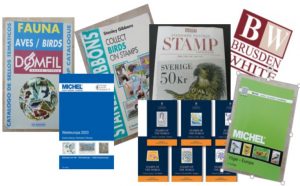
There are very far and few specialised catalogues just for Bird Stamps, which is a shame given that this is possibly the most popular of all the thematic subjects.
Two of these catalogues, Stanley Gibbons ‘Collect Birds on Stamps (CBOS)’, and the Spanish catalogue ‘Domfil’ are both now fairly out of date as neither have been updated.
However, BSS member John Graham has produced a magnificent updated list of birds on stamps up to 2015, which basically continues from where CBOS5 finished. This list is available FREE for BSS members ONLY. We have listed a few catalogues here, with brief reviews – click on the links below to go straight to the catalogues:
- Stanley Gibbons Collect Birds on Stamps
- Michel General Catalogues and European Birds
- Domfil Thematic Stamp Catalogue – Birds
- Brusden-White Catalogues
- The Hibernian – Postage Stamps of Ireland
- The International Postage Meter Stamp Catalogue
- Stamps and Postal History of Lundy Island
- Other Catalogues
Stanley Gibbons – Collect Birds On Stamps (CBOS)

When thematic collecting ‘took off’ in the 80’s, Stanley Gibbons made the decision to create their first ‘Collect Birds on Stamps’ catalogue.
In 2003 the 5th, and regrettably their last, edition was published. The data for all Editions is taken from their simplified world catalogues which for the pure Philatelist lacks the sort of details that they might need.
The simplified catalogues only list the cheapest stamp for all denominations. A large number of the earlier stamps, in particular, have different watermarks, perforations, shades etc. In order to obtain this information, for issues up to 1970, the Commonwealth & British Empire 1840-1970 catalogue is ideal.
For those who concentrate on species and are not that interested in all the varieties then this catalogue, coupled with our own quarterly New Issue listings, and the Post CBOS5 catalogue by member John Graham, is ideal.
CBOS4 lists a total of 24,012 mint & used stamps. CBOS5 added to that number by a considerable amount and although the additions were mostly from where CBOS4 left off, Stanley Gibbons did include issues that were missing from all Editions that were considered worthy of inclusion.
All editions of CBOS exclude Poultry, Domesticated Birds, Peace Doves, Birds that form a Coat of Arms, symbolic birds and any bird that is too stylized or small to be identified.
MICHEL – General Stamp Catalogues and Europa Birds
The first Michel catalogue was published a little over a hundred years ago and they have now become the most comprehensive and significant philatelic reference sources in the German-speaking world.
Their range of catalogues is far larger than the English language offerings with nearly twenty world areas, seven catalogues for Europe alone, nine specialist editions and no less than eleven thematic catalogues – including European birds which is an excellent source.
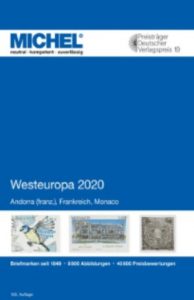
Michel does not issue a complete world set of catalogues every year like Stanley Gibbons or Scott, but instead update selected volumes within their range.
However, their catalogues are far more extensive and detailed in content compared to either Scott or Gibbons, with information on quantities issued, sheet formats, etc. Michel also documents stamps issued apparently with little or no intent of being used to pay postage and stamps issued by regions or areas with uncertain political status.
Michel’s are a must-have for any serious specialist philatelist.
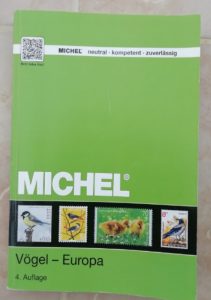
European Birds – the 4th edition, published in 2017 is 512 pages with colour illustrations throughout. It contains more than 5000 illustrations of stamps and miniature sheets.
The text is in German, but there is a supplement available for English speaking readers, and applicable to all Michel catalogues.
The catalogue sadly only covers European birds, but it does include doves, domestic birds, cartoons and stylised birds. It also includes Vending machine / Post and Go issues. The great thing about this catalogue is that in the cases where there may be only 1 or 2 bird stamps within a larger set, ALL stamp images are shown
Domfil Thematic Stamp Catalogue – Birds
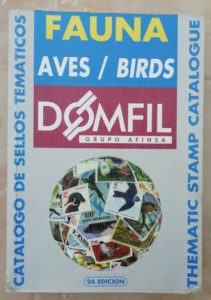
Published in 1999, this is a very useful addition to the library of any bird stamp collector.
It is a 744-page soft-back comprehensive catalogue produced in Spain covering world stamps, and is completely bi-lingual (Spanish and English).
A really useful feature is the use of several catalogue numbers. In addition to Domfil’s own the other catalogues used are Yvert, Michel, Scott and Unificato. Most of the stamps are illustrated with 30% grey-scale images.
Unlike the Michel catalogue, Domfil will only illustrate the bird stamp/s in the case of a mixed set. However, it includes doves, domestic birds, stylised and cartoon birds.
Brusden-White Catalogues

There are number of catalogues for Australian stamps, but the most in-depth and extensively detailed sets are issued by Brusden-White with their Australian Commonwealth Specialist Catalogue series.
First published in 1926 by Orlo-Smith & Co, Brusden-White took over the catalogue in 1988 and then substantially re-organised it into a number of large and highly expansive volumes detailing various periods of Australians issues.
The catalogues are now periodically revised and re-issued with individual volumes covering the following ten areas:-
- Kangaroos
- George V 1913-36
- George VI 1936-52
- Elizabeth II 1952-66 (Pre-Decimal)
- Decimals I – 1966-75
- Decimals II – 1975-91
- Decimals III – 1992-2001
- Postal Stationery
- Postage Dues
- Booklets
Compared to say Scott’s Classic Specialized 1840-1940 catalogue, or Stanley Gibbons Commonwealth & Empire Stamps 1840-1970, all of which are admirable, the BW catalogues go into far greater detail than just perforation and watermark varieties, and offer plate varieties, flaws and a plethora of deeply detailed information.
Whilst expensive, they are nevertheless a philatelic goldmine for the specialist collector.
The Hibernian – Handbook and Catalogue of the Postage Stamps of Ireland
It’s usually abbreviated to just, “The Hibernian,” and the clue is in the title as it acts as both a philatelic tool as well as just a mere catalogue of Irish stamp issues.

Compiled by Roy Hamilton-Bowen and Lee Wolverton, it is now published in Germany but still produced solely in English. It is revised and new editions issued about every five years. The 14th edition (2020) covers issues up to 2019 and currently costs about €50 (£45) including p&p. However, previous editions can be very affordable – I found my second-hand (2009) 12th edition for just £13 and it still contains most of what I need with regard to Irish bird stamps.
The catalogue is arranged very logically and is different from Stanley Gibbons. It is in two basic sections, simplified and specialist. Broadly speaking, the simplified section contains separate sub-sections on overprints, definitives, commemoratives, stamps on rolls, airmails, postage dues, booklets, booklet panes and so forth. The specialist section deals with essays and trials, overprinting issues, errors, coil leaders, papers, gums, plates and so on. It’s a treasure house of material. All the sub-sections in the latest edition are colour coded as well.
The Hibernian also has its own very straightforward catalogue numbering system. Definitives are prefixed “D,” commemoratives “C,” airmails “A,” booklets “HB” and booklet panes “HP.” For collectors of bird stamps its huge advantage is that all the Irish bird definitive issues are together in one section and provide a wealth of detail. If you are interested and collect these stamps, the Hibernian is a highly informative and useful additional to your philatelic library.
The International Postage Meter Stamp Catalogue
This is assuredly a publication for “meter heads,” a select and enthusiastic fraternity of the philatelic community who collect metered mail. Indeed, as far as I am aware, it is the only, and certainly most comprehensive catalogue of all the different types of postage meter stamps that have ever been used to frank mail worldwide and effectively, the definitive publication on this collecting area.
Postal franking meters have been around for quite a while. They came into worldwide use in the 1920s and within forty years it was estimated that more post was being franked by meters than with traditional gummed stamps. This trend has continued by leaps and bounds as the postal franking process has now moved on from mechanical machines to embrace the digital age.
The current internet version is an expansion of the original catalogue written and published by Joel Hawkins and Rick Stambaugh. First published in 2005, the International Postage Meter Stamp Catalogue is now a freely available document issued through Wikibooks on the internet. See the link below:
https://en.wikibooks.org/wiki/International_Postage_Meter_Stamp_Catalog
And it is huge. It is organised by countries alphabetically and arranges and categorises the stamps by their printed appearance – effectively the layout of each design – rather than by the meter model that produced the stamp. Crucially, it is therefore a stamp catalogue for collectors of the printed item and not a catalogue of franking meter machines. There is an informative introduction for those not familiar with metered mail, as well as useful chapters on the historical development of machines, listings of worldwide manufacturers, a glossary of terms and an explanation of the abbreviations and symbols use to denote the stamp types depicted.
If you are interested in metered mail, this publication would be your primary reference source.
Stamps and Postal History of Lundy Island

If you are a Lundy stamp collector, then this illustrated, specialised , priced guide and handbook is a MUST for you! First published in 1984, this is now into the sixth edition, and edited by Jon Aitchison. The catalogue contains stamps, postal history, cancels, cachets, proofs, colour trials, essays, varieties and more. Literature going back 50 years and prominent collections have been researched to ensure the catalogue is as comprehensive as possible. Sections also contain Lundy selection packs, officially produced Lundy covers and coins. Further sections include a contact list giving details of the island, how to obtain new issues from there, the Lundy Collectors Club details and other relevant societies, dealers and auctions. The seventh edition will not appear until 2030, after the 100th anniversary of Lundy stamps.
Other Catalogues
Complementing any specialised bird stamp catalogue, are the complete world catalogues (which might stretch the finances a bit!) from both the American catalogues – Scott (right – showing only 1 of the series), and Stanley Gibbons 6 volume Stamps of the World below. The Scott catalogues show most of the stamps in a set, and not just the first, which seems to be the default in Gibbons catalogues.
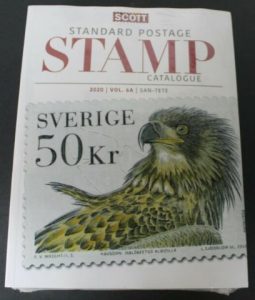

BOOKS ON BIRD STAMPS
Himalayan Birds on Stamps by M Lokeswara Rao
Review by Steve Strauss

This book includes nearly all bird stamps issued by Bhutan, China, India, Nepal, and Pakistan, the five countries of the Himalayan region. The 147 pages, plus the outside and inside front and back covers, are illustrated with more than 430 full-colour illustrations of stamps, sheetlets, first day covers, maxicards, and postcards. There are also a pair of colour maps of the Himalayan region. Rao not only lists, illustrates, and describes the stamps and other philatelic materials, he also includes information about most of the birds.
The first page of the Bhutan chapter includes the following sentence: ‘Straddling the two major Indo-Malayan and Palaearctic biogeographic realms, Bhutan is part of the Eastern Himalayan region which contains parts of three global biodiversity hotspots, 60 ecoregions, 330 Important Bird Areas, 53 important Plant Areas, and a large number of wetlands including 29 Ramsar Sites.’ The author of this reasonably priced and useful book is now retired from the Indian Forest Service. He was the Principal Chief Conservator of Forests and Head of Forest Force. He writes with authority about the Himalayan region, the birds found there, and the bird stamps and other philatelic materials issued by the five Himalayan countries.
Collecting Bird Stamps by Christine E. Jackson
This book will prove a useful guide for anyone starting to collect bird stamps. Published in 1977, 118 pages, and written by an ex-BSS member. The author outlines some of the ways that collections may be built (geographically, zoo-geographically and ornithologically).
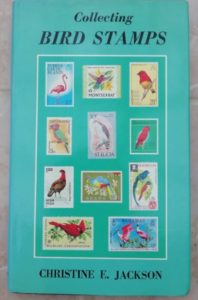
Chapters also include information on:
- Artists and designers;
- Comprehensive and selective collecting of bird stamps;
- What to include and exclude in a collection;
- Errors in the identification and naming of of species illustrated;
- Scope and use of catalogues, and lists of bird stamps; and
- Documentation and Research
This book is very easy to read, and yes, some of the information contained within it is slightly dated, such as costs of stamps, and numbers of stamps available, but this is a great book for a beginner to get ‘up and running’.
Birds, Blocks and Stamps: Post and Go Birds of Britain by Robert Gillmor
Published by Two Rivers Press in October 2011, this 56 page paperback was written by Robert Gillmor, renowned ornithologist, artist, illustrator and author.
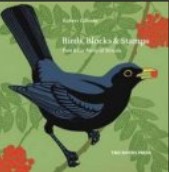
He was commissioned by the Royal Mail to produce four series of stamps (available as Post & Go) featuring British birds. The book is illustrated with larger-than-stamp size prints of the birds .
This is a beautifully produced collection of prints, and outlines the process by which the lino-cuts are made, along with anecdotal descriptions of his bird encounters along the way. The book will be a fine addition to the bookshelves of wildlife lovers, artists and stamp collectors alike.
Handbook of Thematic Philately by W.E.J. van den Bold
Here is just one of a number of books on thematic philately in general. Originally written and published in Dutch by the author in 1990, this 215 page English edition was translated and published in 1994 for the British Thematic Association. The book is an extremely detailed practical guide to building and improving a thematic collection, with a bias on thematic exhibiting.
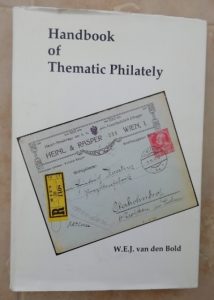
The foreword to the the book states “Every thematic collector should have a copy of this book”!! Many collectors agree that thematic philately is not just about collecting postage stamps, but all available philatelic material: postmarks; machine cancellations; postal stationary and so on, and the book covers this in detail.
The author also intended to show what is necessary to gain awards in the field of thematic philately and exhibiting, and he has certainly achieved this. There is much detail on the regulations and guidelines on this topic, some of which is likely to have been superceded, but this does not have a detrimental effect on the quality of the book in any way.
It is certainly a very interesting read.
The World of Birds on Stamps by Philip J. Lanspeary
This is a book written by another ex-BSS member. Published in 1975, with 328 pages, the book lists all the stamps depicting birds that were issued throughout the world up to the time of going to press.

Much of the book is taken up with a list of birds arranged in alphabetical order of their English names with the species grouped together in families. Additional details show countries featuring each bird listed. There is also a summary of the bird habitat, folklore and history where applicable, and specific stamp details too.
The final section contains an index of all the stamps, listed under countries of issue, together with some short sections on, for example, domestic birds and avian curiosities.
A worthy addition to any bird book collection.
